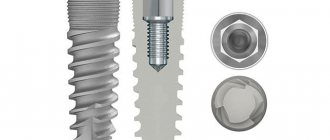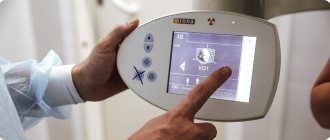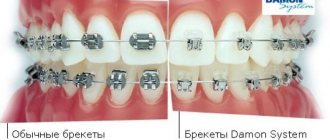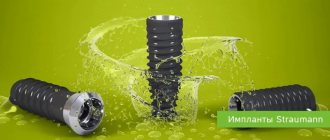Dr. Kizim
>
Articles
>
CAD/CAM technologies in dentistry - a guarantee of accurate and fast results
The idea of using CAD/CAM technology in dentistry appeared in 1971. The first models were bulky and inconvenient to use; the scanners produced significant image distortions, which did not allow the creation of high-quality products. With the improvement of software, the production of prostheses using CAD/CAM technology is gradually replacing classical orthopedic methods.
Stages of CAD/CAM technology in dentistry
The abbreviation CAD/CAM is the first letters of English expressions, which when translated into Russian mean: computer-aided design systems/computer-aided manufacturing systems.
Restoring the integrity of the dentition using CAD/CAM technology consists of three stages:
- Computer diagnostics using a scanner.
- Modeling in 3D format.
- Manufacturing and installation of a prosthesis.
Scanning the oral cavity - creating digital impressions of the dental system and transferring information to a computer. The procedure is performed in two versions: scanning the patient’s mouth directly or a plaster model. The sensitivity of the scanner determines the similarity of the parameters of the virtual model to the dimensions of the real one, which is the main factor in the accuracy of the fit of the finished structure.
Three-dimensional (3D) modeling of orthopedic structures . The resulting image is processed by a computer program that independently generates virtual models of the future prosthesis (inlays, veneers, crowns, bridges). The capabilities of the three-dimensional editor allow the orthopedic doctor to adjust the shape, curvature, wall thickness, and relief of the product. When all corrections are completed, the panoramic computer model proceeds to the next stage - milling.
Milling . The virtual model with the finished design is sent to the system department of the milling machine. The metal block is automatically turned with special cutters in a sequence specified by the computer. The result is a metal product or a solid frame for the crown, which is then filled with ceramic mass and baked in a high-temperature oven.
Grinding, polishing . After firing, the finished product is ground and the surface is finished polished.
Using CAD/CAM technology, the full cycle of prosthesis production is carried out - from a 3D panoramic model to the finished product.
In Russia, the systems Cerec, Organical, Catana and others are used.
Brief economic calculation of a 3D metal printer for dentistry:
1. The cost of the powder (25-40 microns) is 18,000 rubles. Cost (direct) of manufacturing 1 frame (2g product + 1g support) = 3*18=54 rubles. 2. Production time for 60 units – 2 hours. The number of loads per day is 4. The number of manufactured units per day is 240. 3. When one machine is filled to 60% with LSP (240*22*0.6), the total number of units will be 3168 (taking into account defects and rework). 4. With the cost of laser sintering on the market starting from 300 rubles, the gross profit will be 728,000 rubles. 5. The payback of the technology at 60% load will be less than 10 months.
What orthopedic structures are manufactured using the CAD/CAM system?
Unique computer technology allows you to create:
- Crowns made of zirconium and solid ceramics.
- Veneers, inlays.
- Telescopic crowns for clasp dentures.
- Individual abutments.
- Bridge structures.
- Temporary crowns that must be installed in a short time.
- Surgical templates for dental implantation.
The range of use of this technology is constantly expanding, making this section of orthopedics the most promising.
Only with the use of a CAD/CAM system is it possible to process such high-strength materials as oxide and zirconium dioxide, from which beautiful, durable crowns are made.
List of milled materials
- Zirconium dioxide (ZrO2)
- Translucent zirconia (ZrO2)
- Glass ceramic based on lithium disilicate (LS2) - IPS e.max® CAD Ivoclar Vivadent
- Leucite glass ceramics - IPS Empress® CAD Ivoclar Vivadent
- Multiblocks - IPS Empress® CAD Ivoclar Vivadent
- Hybrid ceramics – VITA ENAMIC
- PMMA plastic (polymethyl methacrylate)
- Wax
- Ashless plastic
- Biopolymer PEEK (polyetheretherketone)
Advantages of CAD/CAM technology in dentistry
- High precision in the manufacture of orthopedic structures, which cannot be achieved with other technologies. In the classic version, at any stage of prosthesis manufacturing (taking impressions, casting plaster models, manually creating a frame), small errors inevitably arise, which together lead to inaccuracies in the finished prosthesis, which often requires modification. Dimensional deviation with the CAD/CAM system is 3–5 times lower than with the classical one.
- Orthopedic products using digital technology are characterized by increased strength and durability.
- The process of manufacturing various types of prostheses is fully automated, which eliminates errors caused by the human factor.
- To manufacture prostheses using the CAD/CAM system, it is possible to use various materials: alloys of cobalt and chromium, zirconium dioxide, ceramics, composite materials, since the computer contains several process control programs depending on the substance used.
- The dentures so accurately replicate the anatomical structure of the teeth that the patient does not experience discomfort after installation of the structure, and there is no bleeding, pain or injury to the gums.
- Due to the absence of intermediate stages in the work (taking impressions, casting prosthetic models), the total duration of prosthetics using technology is reduced from 10–14 days to several hours and makes it possible to install the design in 1–2 visits to the doctor.
- The patient can see an image of his future prosthesis on the computer screen, discuss possible options with the dentist, and, if necessary, make adjustments to the final project.
- The patient does not experience any discomfort associated with taking impressions using plaster. This is especially true for people with a pronounced gag reflex.
- Prosthetics using the CAD/CAM system gives a predictable, highly accurate result, taking into account the individual characteristics of the patient.
Best models
The most common model of this system is Dyamach, an Italian manufacturer that produces milling machines for open systems. This equipment allows processing of any type of material - ceramics, metal, plastic. The result is a finished product with a high degree of accuracy.
The milling machine from this company copes well with complex structures due to the high mobility of its working part. The composition includes cutters of various sizes (3,4,6 mm), allowing you to make any type of prosthesis. The equipment operates at high speed, for example, small parts and details (core inlays, abutments) are manufactured in 10-15 minutes, bridge frames - up to 60 minutes. This company is distinguished by low prices combined with high quality products.
Milling a structure in a machine
German manufacturers
Sirona Dental Systems is a German economy class manufacturer, available for all types of dental clinics and dental laboratories. Milling machines from this company can produce many prosthetic elements in a short time.
Wieland is a German manufacturer that produces 2 types of milling machines. The first model has compact dimensions and light weight, is suitable for the manufacture of simple prostheses, and has a low cost. The second model allows the creation of prostheses in difficult clinical situations (telescopic and implant-supported), but has a higher price.
Other countries
Roland is a Japanese manufacturer offering equipment for open systems. It also produces milling machines for creating prosthetics from any materials. Making a unit from a zirconium alloy using this equipment takes about half an hour. The end result is highly accurate.
Zirkonzahn is an Italian manufacturer producing CAD/CAM elements for open-type systems. It contains an intraoral camera, a computer, a framer, and an oven for sintering elements made of ceramics. The products are characterized by low price, simplicity of the computer program and the ability to train doctors to work with the program. This system is ideal for use in low-cost hospitals due to its low price.
Kadkam is a system in dentistry that everyone will like due to the high quality of dentures and affordable cost.
Where is the best place to make prosthetics using CAD/CAM technology?
High-quality prosthetics is not only a snow-white smile, but also a way to restore the main function of teeth - mechanical processing of food. To do this, it is necessary that the dentures not only perform a decorative role, but also withstand heavy chewing loads. It is the CAD/CAM computer technology that guarantees the patient maximum comfort during prosthetics, minimal completion time, strength and long-term service of the prostheses.
Not all dental clinics can offer orthopedic treatment of such a high level.
Dr. Kizim's center provides its patients with the most modern systems for computer modeling and manufacturing, which allow them to create highly accurate and aesthetic prosthetics in the shortest possible time. Doctors at the dental center use new technologies during orthodontic treatment and obtain impeccable results.
If you dream of beautiful and healthy teeth, but don’t have time to spend weeks visiting offices, contact Dr. Kizim’s clinic
Translucent zirconia
Translucent zirconium dioxide is the same zirconium dioxide, but with increased light transmittance. Due to its translucency (transparency), it is suitable for the manufacture of full-anatomical restorations and bridges of any length on all groups of teeth. At the end of the fabrication process, the structure is quickly and efficiently stained or, in the case of anterior restorations, the incisal area is veneered with IPS e.max Ceram Ivoclar Vivadent. High translucency and excellent physical properties of this material provide fantastic opportunities for creating highly aesthetic restorations.
Benefits of zirconia:
- Aesthetics. Thanks to zirconium dioxide, the restorations are so natural that dentures or crowns cannot be distinguished from natural teeth. Zirconium dioxide restorations are optimally integrated into the dentition.
- Light transmission and optical identity to natural teeth. Unlike a metal frame, a zirconium dioxide cap is translucent. The light transmission of zirconium dioxide blanks is close to the light transmission of tooth enamel. A zirconia crown has the color characteristics of natural tooth tissue in transmitted light, consisting of a more opaque core and a more transparent peripheral zone.
- Hypoallergenic and absolute biocompatibility. After prosthetics with metal-ceramic prostheses, an allergic reaction to the metal often begins, sometimes even to a gold-containing alloy. Zirconium dioxide is chemically stable and does not adversely affect either the adjacent periodontal tissues or the condition of the body as a whole. Possible interactions (galvanism) of zirconium dioxide with metal structures already in the patient’s oral cavity are also excluded.
- High mechanical strength. The strength of zirconium dioxide exceeds that of some metal alloys. The fracture force of zirconium dioxide is 1400 MPa (for comparison, the fracture force of a human tooth is 160 MPa), so zirconium dioxide does not deform over time.
- Low thermal conductivity. The low thermal conductivity of zirconium dioxide is especially important for prosthetics of living teeth. A living tooth or implant covered with a zirconium dioxide crown is not susceptible to temperature changes (cold and hot food) compared to a metal-ceramic crown.
- High resistance of dentures to discoloration and wear. This material, having high chemical stability, ensures durability of the color characteristics of the crown and its shape.
- Light weight. Despite their strength, crowns based on zirconium dioxide are much lighter than metal-ceramic crowns (for example: the specific gravity of zirconium dioxide is 6.06 g/cm3 compared to alloys of base metals, the specific gravity of which is 8.2 - 8.4 g/cm3, and the specific gravity of noble metal alloys ranges from 16.1 to 19.2 g/cm3). CATALOG 14
- Absence of a black border along the gingival margin. Zirconium dioxide ceramics avoid all the negative biological and aesthetic problems associated with the metal edge located in the gingival sulcus, which usually becomes noticeable during gum recession.
- High degree of cleanability of crowns. The surface of zirconium dioxide teeth is very smooth, which prevents the accumulation of plaque and the development of periodontal disease, which means that this material is ideal for implant prosthetics. Zirconium dioxide is an acid-resistant and non-porous material that does not absorb toxic substances, which facilitates quick and easy cleaning of the denture, and therefore, oral hygiene.
- Color selection. For the first time, color selection is carried out not only at the level of the ceramic coating, but also at the level of the frame. This allows you to avoid the effect of metal translucency, which is typical for metal-ceramic crowns.
- Adhesion of ceramic veneer to zirconium frame. Due to chemical affinity, the zirconium dioxide frame perfectly connects with the ceramic veneer. Experiments have shown that chipping of ceramics on a zirconium prosthesis more often occurs in the thickness of the ceramic mass, and not along the border of the frame and cladding.
- Property of zirconia that prevents crack progression. If a crack develops in the framework, the yttrium-stabilized tetragonal particles contained in the zirconium dioxide transform into monoclinic ones, which leads to an increase in volume. Due to this phase transformation, a compressive stress arises in the frame, which ideally leads to the cessation of crack progression. This process is referred to as transformation enhancement or the “airbag effect” of zirconia.
Contraindications to the use of metal-free ceramics based on zirconium dioxide:
- The presence of low clinical height of natural teeth (small teeth);
- Deep bite;
- Large defect in the dentition (in this case, metal-ceramic structures are used);
- Bruxism (the exception is bridges with one or more all-zirconium crowns).
Leucite glass ceramic IPS Empress®CAD Ivoclar Vivadent
IPS Empress® CAD is ideal for the production of esthetic monochrome single restorations, such as veneers, inlays, onlays, anterior and posterior crowns.
Thanks to its homogeneity and light diffusion, IPS Empress®CAD has a balanced chameleon effect. In addition to their luminous optical properties, IPS Empress®CAD restorations inspire with natural transparency and high aesthetics.
IPS Empress®CAD leucite glass ceramic blocks are available in two degrees of transparency: HT Blocks (High Translucency), LT Blocks (Low Translucency).
Company news All news
13.12.2021
ADM Dental is the official partner of Ziceram.
ADM Dental is expanding its range of CAD/CAM consumables with zirconium discs from the Russian company Ziceram.
30.11.2021
ADM Dental is an exclusive partner.
ADM Dental is an exclusive partner of , a supplier of high-quality wax CAD/CAM discs for dentistry.
26.11.2021
Increase in prices for Nabertherm sinter furnaces!
You still have time to fix the price for 2022 for yourself before December 25th.
Product examples
Digital dental CADCAM devices and advanced prosthetic materials help create products for a wide range of applications.
Some prostheses:
- Abutments made of various materials (most often titanium);
- Removable prosthetics;
- Metal, non-metal, ceramic, composite and other crowns;
- Templates for surgical procedures;
- Aligners, veneers, onlays and much more.
Special offers
Formlabs Form Wash Automatic Cleaning Device
Vendor code: 120120
NABERTHERM LHT 01/17 LB Speed
Vendor code: 120172
Sintering furnace NABERTHERM LHT 01/17 LB Speed
Formlabs Form 3B 3D printer
Vendor code: 120119
Holder for Pre-milled Aluminum abutments
Vendor code: 110101
NABERTHERM LHT 01/17 D + controller P480
Vendor code: 120138
Sintering furnace NABERTHERM LHT 01/17 D + controller P480
Nabertherm LHT 01/16 Turbo Fire with 500 series controller
Vendor code: 120203
Nabertherm LHT 01/16 Turbo Fire sintering furnace with 500 series controller
Formlabs Form Cure Curing Chamber
Vendor code: 120122
Plastic PMMA (polymethyl methacrylate) VIPI BLOCK® PMMA TRILUX®
PMMA is a highly structured thermoplastic synthetic material (polymethyl methacrylate).
PMMA is used for the manufacture of crowns and bridges as long-term temporary prostheses, the material is extremely resistant to plaque and has high color stability.
Thanks to its exceptional polishability, a unique, long-lasting gloss effect is achieved. In addition, PMMA is highly biocompatible and suitable for all allergy sufferers.
Multiblocks IPS Empress®CAD Ivoclar Vivadent
The innovative IPS Empress®CAD Multi block is suitable for restorations that require a natural transition of color and fluorescence from dentin to the incisal edge, creating maximum esthetics and naturalness.
Advantages:
- Great aesthetics;
- Extensive selection of colors and sizes for any clinical case;
- Polishing with OptraFine - no glaze required Indications Veneers, inlays, inlays and onlays, crowns for front and side teeth.
Hybrid ceramics VITA ENAMIC
VITA ENAMIC is the world's first dental hybrid ceramic with a double mesh structure.
The dominant ceramic mesh structure in the material (86%) is reinforced by a polymer mesh structure (14%), and both of these structures are completely interpenetrable. Thanks to this, VITA ENAMIC, a dental hybrid material, combines the advantages of both ceramics and composites. This innovative hybrid material, in addition to its excellent resistance to stress, also has exceptional elasticity. These material properties are ideal for the execution of single crowns in the posterior sections, and for the first time it has become possible to significantly reduce wall thickness in minimally invasive restorations.
In addition, VITA ENAMIC is extremely reliable, easy to process and guarantees detailed results, even with very thin restoration margins. The properties of the hybrid material are as close as possible to natural tooth tissues and, thanks to its excellent light transmission, reproduces the natural play of color.
Advantages:
- Natural aesthetics;
- Excellent load resistance;
- Exceptional elasticity;
- Unique function of stopping cracks in the polymer structure;
- Minimally invasive restorations;
- Restorations in areas with high chewing load;
- Two degrees of translucency in five colors;
- Fast and economical processing.
Indications:
- Crowns;
- Inlays and overlays;
- VITA ENAMIC veneers are offered in two degrees of translucency: HT=high translucent - highly translucent T=translucent - translucent. And also in five colors in each degree of translucency.










